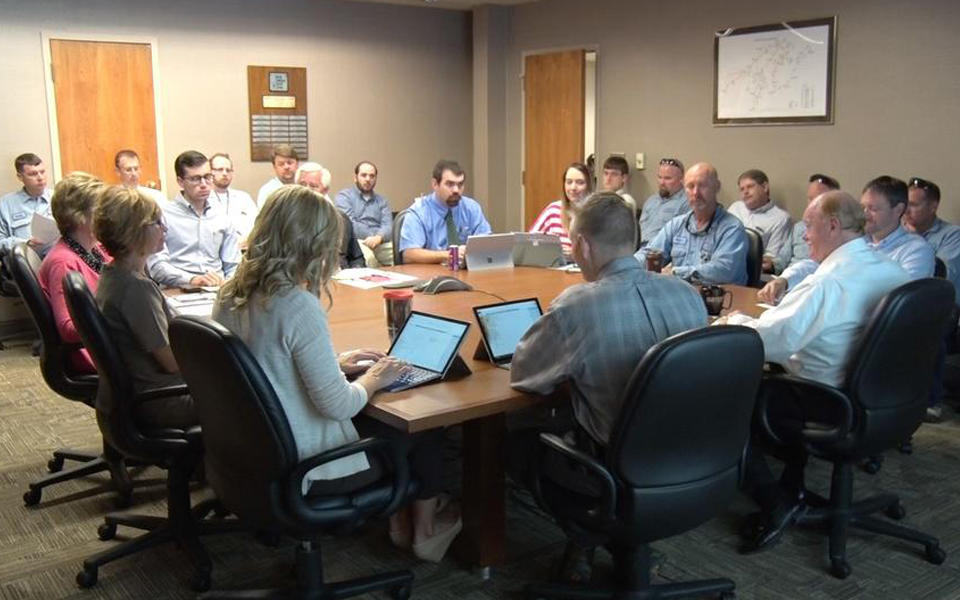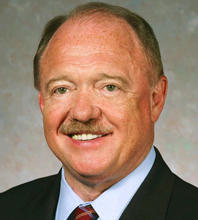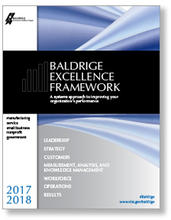Blogrige
The Official Baldrige Blog

BTES's Continuous Improvement Team conducts its Monday morning meeting.
Five-Part Leadership Blog Series
In this five-part blog series on the 2017 Baldrige Award recipients’ leadership presentations at the 30th Anniversary Quest for Excellence® Conference (April 8–11, 2018), senior leaders of the five new national role models share best practices and stories of how they achieved excellence.
Service Growth for a Small Business

Bristol Tennessee Essential Services
2017 Baldrige Award Recipient
Considering the challenge of restoring customers’ power at that time due to the company’s lack of control over the telephone lines it used to transmit power to customers, BTES began researching and then decided to install a fiber-optic communication system. Linking its substations to its office and operations center, this system gave BTES control of its facilities on a daily basis. It also greatly reduced outages at substations, most of which had been caused by lightning strikes to the copper telephone wires, whereas the glass in fiber-optic cable is impervious to such strikes.
The fiber-optic system also allowed BTES to eventually offer cable, Internet, and telephone services for its existing electric customers. After expanding the system in the fall of 2005, BTES began offering cable and Internet services; the following year, it added telephone service. In addition, in 2016 BTES created a local television station, with programming created by its employees to highlight community life, including the school systems and other organizations and people in the area. Today, BTES serves 33,000 electric customers and 17,000 Internet, telephone, and cable television customers.
“No matter how good [we] are this time, next time that is the [customer’s] expectation. ... Every time we have to be better than we were yesterday, and every tomorrow we have to be better [than we are today].” —R. Michael Browder
BTES’s Path to Excellence
BTES’s journey to excellence using the Baldrige Excellence Framework has been greatly supported by its long-time involvement with the Tennessee Center for Performance Excellence (TNCPE) program. (TNCPE is a member of the national Baldrige Program’s partnership network of statewide and regional Baldrige-based programs). BTES won TNCPE’s top-tier award in 2012, becoming eligible to apply for the Malcolm Baldrige National Quality Award for the next five years.
Mission and Vision
To develop its mission statement, BTES gathered employees together to consider the questions in the Baldrige Criteria for Performance Excellence (part of the Baldrige framework) and ask for their input. The result: “To provide service to our customers, employees and community that exceeds their expectations.” Browder pointed out how this mission of exceeding expectations has promoted BTES’s culture of continuous improvement. “No matter how good [we] are this time, next time that is the expectation.” he said. “... every time we have to be better than we were yesterday, and every tomorrow we have to be better [than we are today].”
BTES also asked employees to help develop the company’s vision statement: “To be the best electric, Internet, telephone, and cable television provider.” Among exceptional results that demonstrate its mission and vision, BTES today delivers Internet service to its 33,000 customers at the fastest speed available in the United States: 10 Gigabits per second.
Employees
With just 68 employees, BTES has a retention rate of 100 percent, far exceeding the national industry average of 82 percent and industry benchmark of 91 percent. In addition, 75 percent of BTES employees have perfect attendance, compared to a national industry average of about 20 percent. BTES’s hiring practices are tied to such results. According to Browder’s presentation, inspired by studying Jim Collins’ bestselling book From Good to Great years ago, BTES’s Continuous Improvement Team, which meets every Monday morning, revamped processes to recruit and hire employees who could work for the company for the long term.
To build an effective workforce environment and engage and empower employees, BTES empowers employees to make decisions to improve its products and services, in part by testing ideas and improving work processes. The company also established a “storytelling” technique to build a positive workforce culture. Stories are told to train employees, promote ethical behavior, and build understanding of BTES practices. These workforce communications are based on the company’s CAP DO [Check, Act, Plan, Do] decision-making process.
Key Success Factors
BTES’s “keys to organizational success” according to Browder’s presentation, are reliability, safety, and financial performance. The process of determining these factors involved gathering employees altogether in 2010 and asking them, “What are the things that are most important to BTES, and what are the things that we are the absolute best at?” In recent years, BTES has reviewed and refined its key success factors, decreasing the number to three to enhance its focus on its top priorities.
Results
Browder shared results related to each of his business's three success factors:
Reliability: BTES has annually outperformed its goal of 60 minutes or less of outage time per customer per year since 2014.
Safety: BTES’s average rate of safety incidents per year has been favorably well below the industry average since 1994, with zero incidents in all but two years in that period.
Financial: BTES’s retail revenue less power cost has outperformed industry comparisons for decades, with its 2015 cost about $5 million below one comparison and $15 million below the other.
View more results from BTES.
Five-Part Leadership Blog Series: Upcoming Blogs
Stellar Solutions (Small Business)
Adventist Health Castle (Health Care)
Southcentral Foundation (Health Care)
Previous Blogs
Leadership Practices of the City of Fort Collins (Nonprofit)

Baldrige Excellence Framework
The Baldrige Excellence Framework has empowered organizations to accomplish their missions, improve results, and become more competitive. It includes the Criteria for Performance Excellence, core values and concepts, and guidelines for evaluating your processes and results.
Purchase your copy today!
Available versions: Business/Nonprofit, Education, and Health Care





